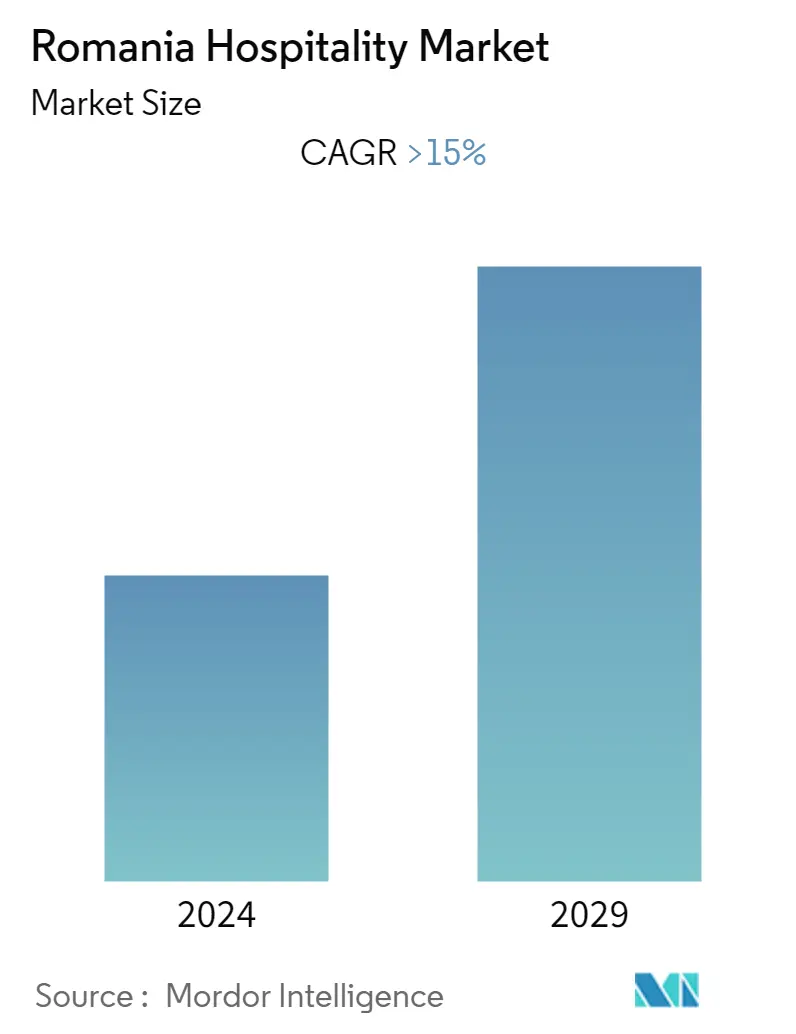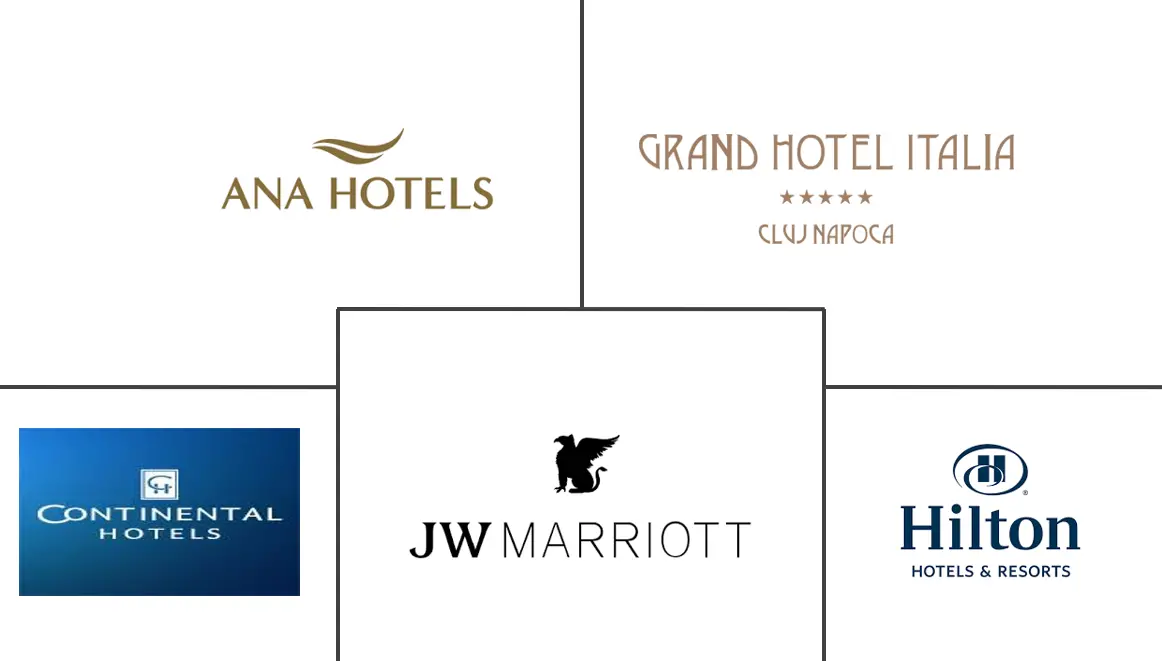Market Size of Romania Hospitality Industry

| Study Period | 2020 - 2029 |
| Base Year For Estimation | 2023 |
| Forecast Data Period | 2024 - 2029 |
| Historical Data Period | 2020 - 2022 |
| CAGR | > 15.00 % |
| Market Concentration | Medium |
Major Players
*Disclaimer: Major Players sorted in no particular order |
Romania Hospitality Market Analysis
Romania's Hospitality Industry has generated a revenue of USD 2 billion in the current year and is poised to register a CAGR of 15% for the forecast period. Romania has experienced a steady increase in tourist arrivals, both from domestic and international sources. The country's rich cultural heritage, natural beauty, and affordability have attracted a diverse range of travelers. Popular tourist destinations include Bucharest, Transylvania, the Danube Delta, and the Black Sea coast. The accommodation sector in Romania offers a variety of options, ranging from luxury hotels and resorts to budget hotels, guesthouses, and vacation rentals. Major international hotel chains have a strong presence in the country, providing standardized services and amenities. Additionally, independent hotels, boutique hotels, and traditional guesthouses contribute to the diverse accommodation landscape.
Romania's rural areas offer opportunities for rural tourism and ecotourism. Visitors can experience authentic village life, participate in agricultural activities, and explore the country's natural landscapes. This type of tourism supports local communities, promotes sustainable practices, and highlights Romania's natural and cultural heritage. The digital transformation has impacted the Romanian hospitality market with the rise of online travel agencies (OTAs) and vacation rental platforms. Travelers can easily book accommodations, compare prices, and read reviews through various online platforms. Technology also plays a role in hotel operations, guest services, and marketing efforts.
The Romanian hospitality industry faces certain challenges. These include seasonality, where tourist arrivals are concentrated in specific periods and the need for infrastructure improvements in some regions. The COVID-19 pandemic also significantly impacted the market, leading to temporary closures, travel restrictions, and changes in consumer behavior. However, as the situation improved, the industry was gradually recovering.
Romania Hospitality Industry Segmentation
Hospitality means welcoming a guest and making them comfortable at your place by looking after their needs during their temporary stay. The hospitality industry in Romania refers to the total transactions recorded by various accommodation establishments in Romania. The study captures the market value of the hospitality industry in Romania. The Romania Hospitality Industry is segmented By Type (Chain Hotels and Independent Hotels) and By Category (Upscale and Luxury Hotels, Mid-Scale Hotels, and Budget and Economy Hotels). The report offers market size and forecasts for the Romania Hospitality Industry in value (USD) for all the above segments.
| By Type | |
| Chain Hotels | |
| Independent Hotels |
| By Hotel Category | |
| Upscale and Luxury Hotels | |
| Mid-Scale Hotels | |
| Budget and Economy Hotels |
Romania Hospitality Market Size Summary
The Romanian hospitality industry is experiencing robust growth, driven by an increase in both domestic and international tourist arrivals. The country's appeal lies in its rich cultural heritage, natural beauty, and affordability, making it a favored destination for a diverse range of travelers. Key tourist spots such as Bucharest, Transylvania, the Danube Delta, and the Black Sea coast attract visitors, while the accommodation sector offers a wide array of options, from luxury hotels and resorts to budget-friendly guesthouses and vacation rentals. The presence of major international hotel chains, alongside independent and boutique hotels, contributes to a vibrant and varied accommodation landscape. Additionally, rural and ecotourism opportunities in Romania's countryside promote sustainable tourism practices and support local communities. The digital transformation, marked by the rise of online travel agencies and vacation rental platforms, has further influenced the market, enhancing the ease of booking and guest services.
Despite challenges such as seasonality and infrastructure needs, the Romanian hospitality industry is on a recovery path following the COVID-19 pandemic's impact. The country's mountain tourism, particularly winter sports, continues to attract visitors, reinforcing Romania's position as an emerging European destination. The affordability of Romania as a travel destination, combined with its diverse offerings, appeals to budget-conscious travelers. The competitive landscape is dynamic, with various players striving to differentiate themselves through service quality, location, and unique offerings. The capital, Bucharest, boasts a developed hotel market, predominantly featuring 4- and 5-star establishments. Prominent industry players include Ana Hotels, Grand Hotel Italia, Continental Hotels, JW Marriott Hotels, and Hilton Worldwide, with ongoing expansions and upgrades enhancing the hospitality experience in Romania.
Romania Hospitality Market Size - Table of Contents
-
1. MARKET DYNAMICS AND INSIGHTS
-
1.1 Market Overview
-
1.2 Market Drivers
-
1.2.1 Increasing Tourist Arrivals
-
1.2.2 Quality and Service Standards
-
-
1.3 Market Restraints
-
1.3.1 Skill Shortages and Labor Costs
-
1.3.2 Regulatory Challenges and Administrative Burdens
-
-
1.4 Industry Attractiveness - Porter's Five Forces Analysis
-
1.4.1 Bargaining Power of Buyers
-
1.4.2 Bargaining Power of Suppliers
-
1.4.3 Threat of New Entrants
-
1.4.4 Threat of Substitutes
-
1.4.5 Intensity of Competitive Rivalry
-
-
1.5 Technological Innovation in the Hospitality Industry
-
1.6 Impact of COVID-19 on the Hospitality Industry
-
1.7 Insights on International and Domestic Visitors in Romania
-
1.8 Insights on Revenue Flows from Accommodation and Food and Beverage Sectors
-
1.9 Investments (Real Estate, FDI, and others) in the Hospitality Industry
-
1.10 Loyalty Programs Offered by Major Hotels in the Country
-
-
2. MARKET SEGMENTATION
-
2.1 By Type
-
2.1.1 Chain Hotels
-
2.1.2 Independent Hotels
-
-
2.2 By Hotel Category
-
2.2.1 Upscale and Luxury Hotels
-
2.2.2 Mid-Scale Hotels
-
2.2.3 Budget and Economy Hotels
-
-
Romania Hospitality Market Size FAQs
What is the current Romania Hospitality Market size?
The Romania Hospitality Market is projected to register a CAGR of greater than 15% during the forecast period (2024-2029)
Who are the key players in Romania Hospitality Market?
Ana Hotels, Grand Hotel Italia, Continental Hotels, JW Marriott Hotels and Hilton Worldwide are the major companies operating in the Romania Hospitality Market.

